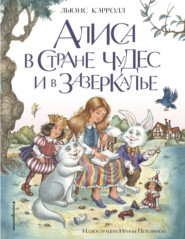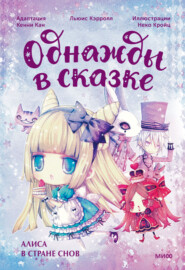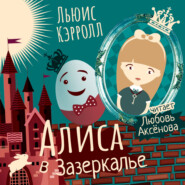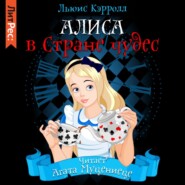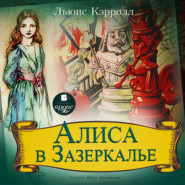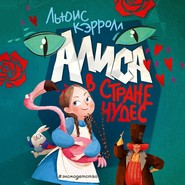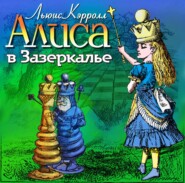По всем вопросам обращайтесь на: info@litportal.ru
(©) 2003-2025.
✖
Through The Looking Glass
Автор
Год написания книги
2019
Настройки чтения
Размер шрифта
Высота строк
Поля
Through The Looking Glass
Lewis Carroll
HarperCollins is proud to present a range of best-loved, essential classics.'It's a poor sort of memory that only works backward.'In Carroll's sequel to Alice's Adventures in Wonderland, Alice once again finds herself in a bizarre and nonsensical place when she passes through a mirror and enters a looking-glass world where nothing is quite as it seems. From her guest appearance as a pawn in a chess match to her meeting with Humpty Dumpty, Through the Looking Glass follows Alice on her curious adventure and shows Carroll's great skill at creating an imaginary world full of the fantastical and extraordinary.
Collins Classics
History of Collins (#ulink_22240b0f-2c24-50be-beac-7486bee96bb9)
In 1819, Millworker William Collins from Glasgow, Scotland, set up a company for printing and publishing pamphlets, sermons, hymn books and prayer books. That company was Collins and was to mark the birth of HarperCollins Publishers as we know it today. The long tradition of Collins dictionary publishing can be traced back to the first dictionary William published in 1824, Greek and English Lexicon. Indeed, from 1840 onwards, he began to produce illustrated dictionaries and even obtained a licence to print and publish the Bible.
Soon after, William published the first Collins novel, Ready Reckoner, however it was the time of the Long Depression, where harvests were poor, prices were high, potato crops had failed and violence was erupting in Europe. As a result, many factories across the country were forced to close down and William chose to retire in 1846, partly due to the hardships he was facing.
Aged 30, William’s son, William II took over the business. A keen humanitarian with a warm heart and a generous spirit, William II was truly ‘Victorian’ in his outlook. He introduced new, up-to-date steam presses and published affordable editions of Shakespeare’s works and Pilgrim’s Progress, making them available to the masses for the first time. A new demand for educational books meant that success came with the publication of travel books, scientific books, encyclopaedias and dictionaries. This demand to be educated led to the later publication of atlases and Collins also held the monopoly on scripture writing at the time.
In the 1860s Collins began to expand and diversify and the idea of ‘books for the millions’ was developed. Affordable editions of classical literature were published and in 1903 Collins introduced 10 titles in their Collins Handy Illustrated Pocket Novels. These proved so popular that a few years later this had increased to an output of 50 volumes, selling nearly half a million in their year of publication. In the same year, The Everyman’s Library was also instituted, with the idea of publishing an affordable library of the most important classical works, biographies, religious and philosophical treatments, plays, poems, travel and adventure. This series eclipsed all competition at the time and the introduction of paperback books in the 1950s helped to open that market and marked a high point in the industry.
HarperCollins is and has always been a champion of the classics and the current Collins Classics series follows in this tradition – publishing classical literature that is affordable and available to all. Beautifully packaged, highly collectible and intended to be reread and enjoyed at every opportunity.
Life & Times (#ulink_22ef715b-a601-596e-b7ce-4cc31f171fd0)
About the Author
The author of Lewis Carroll’s Alice’s Adventures in Wonderland and Through The Looking Glass was in fact a Charles Ludwidge Dodgson (1832—98). He published under the pseudonym Lewis Carroll because he wished to maintain anonymity and so remain relatively immune to any criticism of his poetry and prose. He actually came up with his pen name by translating his first two names into Latin ‘Carolus Lodovicus’ and then Anglicizing them to ‘Lewis Carroll’, a perfect example of his love for the playfulness of language.
Charles Dodgson’s place of birth was a parsonage in the county of Cheshire, England, as his father was an Anglican parson. The family moved to the county of Yorkshire when he was eleven, by which time Queen Victoria had been on the throne for four years.
He and his siblings were home tutored which had an inevitable effect on their ability to socialize. All of the children also suffered from speech stammering. As a result, this self-consciousness was something that pervaded and continued to affect Charles for the rest of his life.
For two years Dodgson attended a school in Richmond, Yorkshire, and then he was sent to Rugby School at the age of fourteen. Like his father, he showed great promise as a mathematician and went on to academic success at Oxford University, even winning a lectureship, which kept him fiscally well off for many years.
Like his father, he decided to enter the church and became an Anglican deacon at Christ Church, Oxford, although his relationship with Christianity was one with which he wrestled. He was, at heart, a liberal thinker, as his literary work would eventually betray.
As well as his stammer, which he referred to as his ‘hesitation’, he was also deaf in one ear and had a weak chest, resulting from childhood ailments. It may well have been these psychological and physical flaws that translated into his drive to succeed as a writer and him becoming a prominent member of society.
Having always written short stories and drawn illustrations, Dodgson began publishing his own magazine in 1855 as a means of creative expression. It was titled the Mischmasch (German for ‘mishmash’) as the magazine was a mishmash of ideas designed for the amusement of his family. Then, in 1856, he had the opportunity to officially publish some work in The Train: A First-Class Magazine, which was a short lived monthly magazine and prompted him to invent his pseudonym Lewis Carroll.
It was at this time that Dodgson became acquainted with a new colleague, Henry Liddell, and his young family. It’s likely that he felt less intimidated by children, and so was probably less self conscious about his stammer. Dodgson grew very fond of Liddell’s son and three daughters and they proved to be the perfect audience for his imaginative stories. It was in this way that he was encouraged to write Alice’s Adventures in Wonderland. The story goes that he orated the first version to Liddell’s three daughters, Lorina, Alice and Edith, whilst on a boat trip and it was Alice Liddell who urged him to commit the adventures to paper. It took him three years to complete the manuscript to his satisfaction and to finally have the book published in 1865. The book quickly caught the collective imagination of Victorian society and became something of a publishing sensation. In fact, it has never been out of print and has been translated into almost every language, such is its universal popularity.
In 1871 Dodgson published a new book about Alice, titled Through the Looking Glass and What Alice Found There. Apparently his inspiration was another conversation with Alice Liddell, where they discussed what it might be like to enter the reflected world in a mirror. Although a sequel to Alice’s Adventures in Wonderland, there are no references to the events of the first book, but the themes, ideas and characters do seem to echo and mirror those of Alice’s Adventures in Wonderland. This second book was every bit as successful as the first.
The Victorian Era
There was a paradox about the Victorian era during which Dodgson lived. On the one hand it was conservative and formalized, but on the other it was progressive and dynamic. In 1859 Charles Darwin had published On the Origin of Species, in which he had revealed his theory of biological evolution by natural selection. It famously caused a great deal of scientific and theological argument, but it also had the effect of allowing people to think more laterally or outside of the box, because it showed that preconceived ideas may no longer be appropriate or correct.
Dodgson was already a creative mind and it was in this revolutionary environment that he allowed his imagination to ferment the fantastical ideas that would evolve into Alice’s Adventures in Wonderland. His fertile imaginings were honed by using the Liddell children as his sounding board, so that he developed an instinct for writing prose that appealed to children and adults alike.
His two books about Alice are now described as literary nonsense as he was the first author to allow himself the creative license to go wherever his mind took him. As a result he produced stories that enter absurd worlds with anthropomorphic animals and other strange characters with exaggerated personality traits. All of the time though, Dodgson uses the scenarios to tackle problems relating to logic, reason and philosophical conundrums, so that there is far more to the books than there would immediately seem.
Queen Victoria herself was a fan of Dodgson’s work, demonstrating that she and many other Victorians were open to the idea of allowing a little nonsense into their lives. It probably came as a welcome counter balance to the weight of austerity that typified the age in other respects.
Dodgson’s work also set a benchmark for new writers. Literary nonsense became a genre in its own right and many subsequent authors have drawn inspiration from Dodgson’s ability to delve into his subconscious, almost as if he were taking psychedelic drugs to conjure a dream-like place, that he called Wonderland. In effect, Dodgson realised that literature is a true art form, just like painting or sculpture, in that so-called rules are there only to be tested and reset in the creative process.
Incidentally it seems likely that Dodgson had indeed tried hallucinogenic drugs. Opium smoking dens existed in Victorian London as it was long before the drug was made illegal. In addition to this, it was known that Psilocybin mushrooms could be consumed to induce mind bending effects. In the book a shrunken Alice meets a caterpillar, smoking a hookah pipe and reclining on a mushroom. Alice consumes morsels of mushroom that make her first shrink even smaller and then grow back to her normal size. Surely drugs had something to do with such ideas.
Themes of the Book
It is perhaps inevitable that people have read between the lines a great deal with Alice’s Adventures in Wonderland and Through The Looking Glass. That is to say, they have searched for a hidden meaning, agenda or allegory that Dodgson wished to express through his work. It seems more likely though that it is what it is – literary nonsense. The books are an exploration of imagined possibilities.
Dodgson doesn’t seem to have harboured any desire to pass comment on Victorian society. Although it is known that many of his literary characters were based on the personalities of his friends, it seems that this was merely an aid to character creation and development rather than any intention to parody them in any way. He was a humanist at heart, so he used his friends because he enjoyed and celebrated their idiosyncrasies and foibles.
It was this encapsulation of the human condition that seems to have made his work so popular, because the characters are in fact familiar stereotypes, so that readers can recognise traits in themselves and in the people they know. What is more, they are ubiquitous traits, so that they exist in people the world over. For example; Alice is the attractively inquisitive and naive girl, the white rabbit is the neurotic clerk, the caterpillar is the laid back artist, and so on.
Visit www.AuthorTracker.com for exclusive information on your favorite HarperCollins author.
Poem (#ulink_f078f5eb-b232-5698-9c05-4d3c41c985fc)
Child of the pure unclouded browAnd dreaming eyes of wonder!Though time be fleet, and I and thouAre half a life asunder,Thy loving smile will surely hailThe love-gift of a fairy-tale.
I have not seen thy sunny face,Nor heard thy silver laughter;No thought of me shall find a placeIn thy young life’s hereafter – Enough that now thou wilt not failTo listen to my fairy-tale.
A tale begun in other days,When summer suns were glowing –A simple chime, that served to timeThe rhythm of our rowing –Whose echoes live in memory yet,Though envious years would say ‘forget.’
Come, hearken then, ere voice of dread,With bitter tidings laden,Shall summon to unwelcome bedA melancholy maiden!We are but older children, dear,Who fret to find our bedtime near.
Without, the frost, the blinding snow,The storm-wind’s moody madness –Within, the firelight’s ruddy glowAnd childhood’s nest of gladness.
The magic words shall hold thee fast:Thou shalt not heed the raving blast.
And though the shadow of a sighMay tremble through the story,For ‘happy summer days’ gone by,And vanish’d summer glory –It shall not touch with breath of baleThe pleasance of our fairy-tale.
AUTHOR’S NOTE (#ulink_48e5d1fe-827a-5067-a7a6-d5f99a0c2379)
As the chess-problem, given on the next page, has puzzled some of my readers, it may be well to explain that it is correctly worked out, so far as the moves are concerned. The alternation of Red and White is perhaps not so strictly observed as it might be, and the ‘castling’ of the three Queens is merely a way of saying that they entered the palace: but the ‘check’ of the White King at move 6, the capture of the Red Knight at move 7, and the final ‘checkmate’ of the Red King, will be found, by any one who will take the trouble to set the pieces and play the moves as directed, to be strictly in accordance with the laws of the game.
The new words, in the poem ‘Jabberwocky’ (see page 175), have given rise to some differences of opinion as to their pronunciation: so it may be well to give instructions on that point also. Pronounce ‘slithy’ as if it were the two words, ‘sly, the’: make the ‘g’ hard in ‘gyre’ and ‘gimble’: and pronounce ‘rath’ to rhyme with ‘bath.’
Christmas, 1896
Dramatis Personae
(As arranged before commencement of game)
RED
WHITE
White Pawn (Alice) to play, and win in eleven moves
Table of Contents
Lewis Carroll
HarperCollins is proud to present a range of best-loved, essential classics.'It's a poor sort of memory that only works backward.'In Carroll's sequel to Alice's Adventures in Wonderland, Alice once again finds herself in a bizarre and nonsensical place when she passes through a mirror and enters a looking-glass world where nothing is quite as it seems. From her guest appearance as a pawn in a chess match to her meeting with Humpty Dumpty, Through the Looking Glass follows Alice on her curious adventure and shows Carroll's great skill at creating an imaginary world full of the fantastical and extraordinary.
Collins Classics
History of Collins (#ulink_22240b0f-2c24-50be-beac-7486bee96bb9)
In 1819, Millworker William Collins from Glasgow, Scotland, set up a company for printing and publishing pamphlets, sermons, hymn books and prayer books. That company was Collins and was to mark the birth of HarperCollins Publishers as we know it today. The long tradition of Collins dictionary publishing can be traced back to the first dictionary William published in 1824, Greek and English Lexicon. Indeed, from 1840 onwards, he began to produce illustrated dictionaries and even obtained a licence to print and publish the Bible.
Soon after, William published the first Collins novel, Ready Reckoner, however it was the time of the Long Depression, where harvests were poor, prices were high, potato crops had failed and violence was erupting in Europe. As a result, many factories across the country were forced to close down and William chose to retire in 1846, partly due to the hardships he was facing.
Aged 30, William’s son, William II took over the business. A keen humanitarian with a warm heart and a generous spirit, William II was truly ‘Victorian’ in his outlook. He introduced new, up-to-date steam presses and published affordable editions of Shakespeare’s works and Pilgrim’s Progress, making them available to the masses for the first time. A new demand for educational books meant that success came with the publication of travel books, scientific books, encyclopaedias and dictionaries. This demand to be educated led to the later publication of atlases and Collins also held the monopoly on scripture writing at the time.
In the 1860s Collins began to expand and diversify and the idea of ‘books for the millions’ was developed. Affordable editions of classical literature were published and in 1903 Collins introduced 10 titles in their Collins Handy Illustrated Pocket Novels. These proved so popular that a few years later this had increased to an output of 50 volumes, selling nearly half a million in their year of publication. In the same year, The Everyman’s Library was also instituted, with the idea of publishing an affordable library of the most important classical works, biographies, religious and philosophical treatments, plays, poems, travel and adventure. This series eclipsed all competition at the time and the introduction of paperback books in the 1950s helped to open that market and marked a high point in the industry.
HarperCollins is and has always been a champion of the classics and the current Collins Classics series follows in this tradition – publishing classical literature that is affordable and available to all. Beautifully packaged, highly collectible and intended to be reread and enjoyed at every opportunity.
Life & Times (#ulink_22ef715b-a601-596e-b7ce-4cc31f171fd0)
About the Author
The author of Lewis Carroll’s Alice’s Adventures in Wonderland and Through The Looking Glass was in fact a Charles Ludwidge Dodgson (1832—98). He published under the pseudonym Lewis Carroll because he wished to maintain anonymity and so remain relatively immune to any criticism of his poetry and prose. He actually came up with his pen name by translating his first two names into Latin ‘Carolus Lodovicus’ and then Anglicizing them to ‘Lewis Carroll’, a perfect example of his love for the playfulness of language.
Charles Dodgson’s place of birth was a parsonage in the county of Cheshire, England, as his father was an Anglican parson. The family moved to the county of Yorkshire when he was eleven, by which time Queen Victoria had been on the throne for four years.
He and his siblings were home tutored which had an inevitable effect on their ability to socialize. All of the children also suffered from speech stammering. As a result, this self-consciousness was something that pervaded and continued to affect Charles for the rest of his life.
For two years Dodgson attended a school in Richmond, Yorkshire, and then he was sent to Rugby School at the age of fourteen. Like his father, he showed great promise as a mathematician and went on to academic success at Oxford University, even winning a lectureship, which kept him fiscally well off for many years.
Like his father, he decided to enter the church and became an Anglican deacon at Christ Church, Oxford, although his relationship with Christianity was one with which he wrestled. He was, at heart, a liberal thinker, as his literary work would eventually betray.
As well as his stammer, which he referred to as his ‘hesitation’, he was also deaf in one ear and had a weak chest, resulting from childhood ailments. It may well have been these psychological and physical flaws that translated into his drive to succeed as a writer and him becoming a prominent member of society.
Having always written short stories and drawn illustrations, Dodgson began publishing his own magazine in 1855 as a means of creative expression. It was titled the Mischmasch (German for ‘mishmash’) as the magazine was a mishmash of ideas designed for the amusement of his family. Then, in 1856, he had the opportunity to officially publish some work in The Train: A First-Class Magazine, which was a short lived monthly magazine and prompted him to invent his pseudonym Lewis Carroll.
It was at this time that Dodgson became acquainted with a new colleague, Henry Liddell, and his young family. It’s likely that he felt less intimidated by children, and so was probably less self conscious about his stammer. Dodgson grew very fond of Liddell’s son and three daughters and they proved to be the perfect audience for his imaginative stories. It was in this way that he was encouraged to write Alice’s Adventures in Wonderland. The story goes that he orated the first version to Liddell’s three daughters, Lorina, Alice and Edith, whilst on a boat trip and it was Alice Liddell who urged him to commit the adventures to paper. It took him three years to complete the manuscript to his satisfaction and to finally have the book published in 1865. The book quickly caught the collective imagination of Victorian society and became something of a publishing sensation. In fact, it has never been out of print and has been translated into almost every language, such is its universal popularity.
In 1871 Dodgson published a new book about Alice, titled Through the Looking Glass and What Alice Found There. Apparently his inspiration was another conversation with Alice Liddell, where they discussed what it might be like to enter the reflected world in a mirror. Although a sequel to Alice’s Adventures in Wonderland, there are no references to the events of the first book, but the themes, ideas and characters do seem to echo and mirror those of Alice’s Adventures in Wonderland. This second book was every bit as successful as the first.
The Victorian Era
There was a paradox about the Victorian era during which Dodgson lived. On the one hand it was conservative and formalized, but on the other it was progressive and dynamic. In 1859 Charles Darwin had published On the Origin of Species, in which he had revealed his theory of biological evolution by natural selection. It famously caused a great deal of scientific and theological argument, but it also had the effect of allowing people to think more laterally or outside of the box, because it showed that preconceived ideas may no longer be appropriate or correct.
Dodgson was already a creative mind and it was in this revolutionary environment that he allowed his imagination to ferment the fantastical ideas that would evolve into Alice’s Adventures in Wonderland. His fertile imaginings were honed by using the Liddell children as his sounding board, so that he developed an instinct for writing prose that appealed to children and adults alike.
His two books about Alice are now described as literary nonsense as he was the first author to allow himself the creative license to go wherever his mind took him. As a result he produced stories that enter absurd worlds with anthropomorphic animals and other strange characters with exaggerated personality traits. All of the time though, Dodgson uses the scenarios to tackle problems relating to logic, reason and philosophical conundrums, so that there is far more to the books than there would immediately seem.
Queen Victoria herself was a fan of Dodgson’s work, demonstrating that she and many other Victorians were open to the idea of allowing a little nonsense into their lives. It probably came as a welcome counter balance to the weight of austerity that typified the age in other respects.
Dodgson’s work also set a benchmark for new writers. Literary nonsense became a genre in its own right and many subsequent authors have drawn inspiration from Dodgson’s ability to delve into his subconscious, almost as if he were taking psychedelic drugs to conjure a dream-like place, that he called Wonderland. In effect, Dodgson realised that literature is a true art form, just like painting or sculpture, in that so-called rules are there only to be tested and reset in the creative process.
Incidentally it seems likely that Dodgson had indeed tried hallucinogenic drugs. Opium smoking dens existed in Victorian London as it was long before the drug was made illegal. In addition to this, it was known that Psilocybin mushrooms could be consumed to induce mind bending effects. In the book a shrunken Alice meets a caterpillar, smoking a hookah pipe and reclining on a mushroom. Alice consumes morsels of mushroom that make her first shrink even smaller and then grow back to her normal size. Surely drugs had something to do with such ideas.
Themes of the Book
It is perhaps inevitable that people have read between the lines a great deal with Alice’s Adventures in Wonderland and Through The Looking Glass. That is to say, they have searched for a hidden meaning, agenda or allegory that Dodgson wished to express through his work. It seems more likely though that it is what it is – literary nonsense. The books are an exploration of imagined possibilities.
Dodgson doesn’t seem to have harboured any desire to pass comment on Victorian society. Although it is known that many of his literary characters were based on the personalities of his friends, it seems that this was merely an aid to character creation and development rather than any intention to parody them in any way. He was a humanist at heart, so he used his friends because he enjoyed and celebrated their idiosyncrasies and foibles.
It was this encapsulation of the human condition that seems to have made his work so popular, because the characters are in fact familiar stereotypes, so that readers can recognise traits in themselves and in the people they know. What is more, they are ubiquitous traits, so that they exist in people the world over. For example; Alice is the attractively inquisitive and naive girl, the white rabbit is the neurotic clerk, the caterpillar is the laid back artist, and so on.
Visit www.AuthorTracker.com for exclusive information on your favorite HarperCollins author.
Poem (#ulink_f078f5eb-b232-5698-9c05-4d3c41c985fc)
Child of the pure unclouded browAnd dreaming eyes of wonder!Though time be fleet, and I and thouAre half a life asunder,Thy loving smile will surely hailThe love-gift of a fairy-tale.
I have not seen thy sunny face,Nor heard thy silver laughter;No thought of me shall find a placeIn thy young life’s hereafter – Enough that now thou wilt not failTo listen to my fairy-tale.
A tale begun in other days,When summer suns were glowing –A simple chime, that served to timeThe rhythm of our rowing –Whose echoes live in memory yet,Though envious years would say ‘forget.’
Come, hearken then, ere voice of dread,With bitter tidings laden,Shall summon to unwelcome bedA melancholy maiden!We are but older children, dear,Who fret to find our bedtime near.
Without, the frost, the blinding snow,The storm-wind’s moody madness –Within, the firelight’s ruddy glowAnd childhood’s nest of gladness.
The magic words shall hold thee fast:Thou shalt not heed the raving blast.
And though the shadow of a sighMay tremble through the story,For ‘happy summer days’ gone by,And vanish’d summer glory –It shall not touch with breath of baleThe pleasance of our fairy-tale.
AUTHOR’S NOTE (#ulink_48e5d1fe-827a-5067-a7a6-d5f99a0c2379)
As the chess-problem, given on the next page, has puzzled some of my readers, it may be well to explain that it is correctly worked out, so far as the moves are concerned. The alternation of Red and White is perhaps not so strictly observed as it might be, and the ‘castling’ of the three Queens is merely a way of saying that they entered the palace: but the ‘check’ of the White King at move 6, the capture of the Red Knight at move 7, and the final ‘checkmate’ of the Red King, will be found, by any one who will take the trouble to set the pieces and play the moves as directed, to be strictly in accordance with the laws of the game.
The new words, in the poem ‘Jabberwocky’ (see page 175), have given rise to some differences of opinion as to their pronunciation: so it may be well to give instructions on that point also. Pronounce ‘slithy’ as if it were the two words, ‘sly, the’: make the ‘g’ hard in ‘gyre’ and ‘gimble’: and pronounce ‘rath’ to rhyme with ‘bath.’
Christmas, 1896
Dramatis Personae
(As arranged before commencement of game)
RED
WHITE
White Pawn (Alice) to play, and win in eleven moves
Table of Contents






